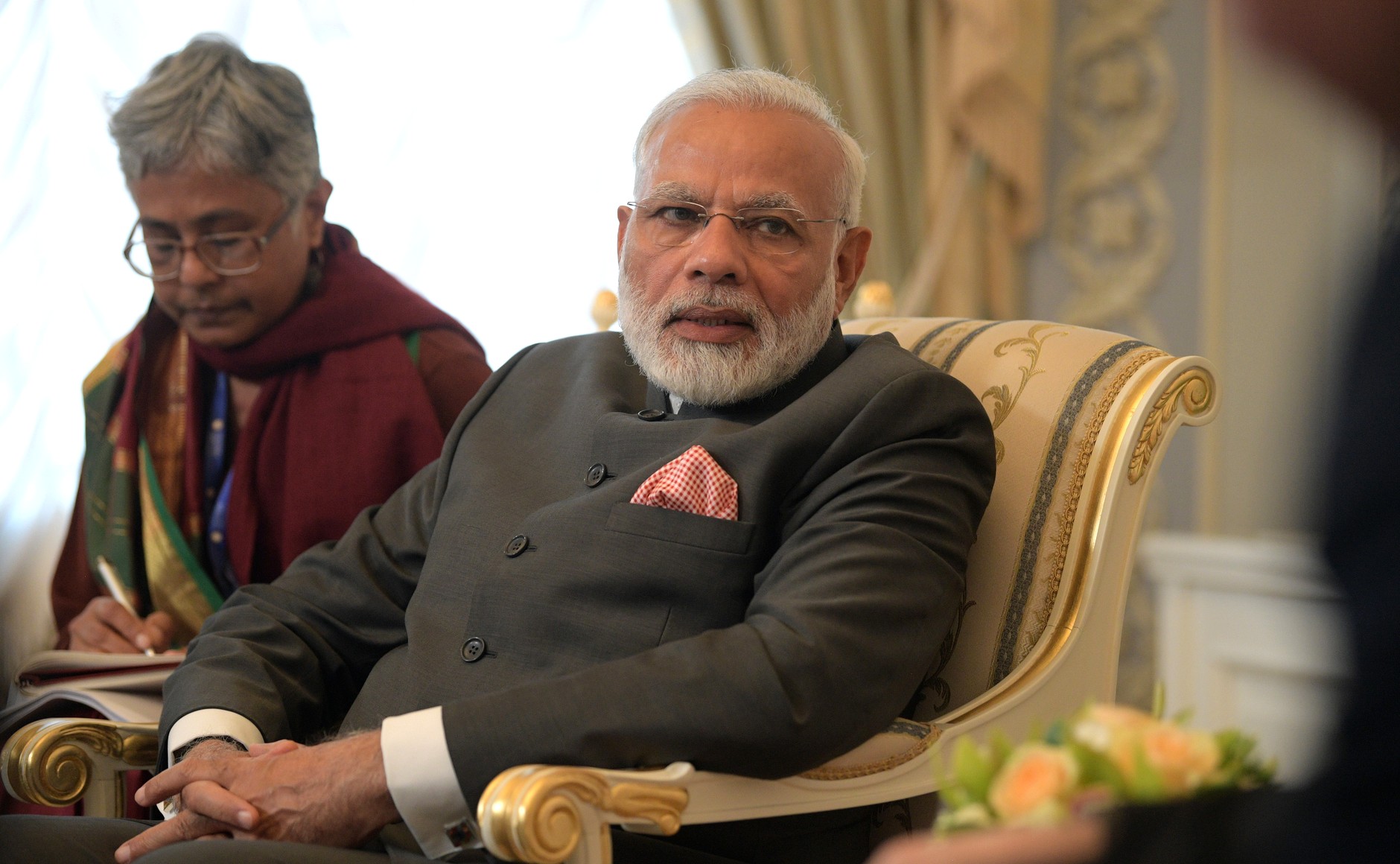The results of the general elections in India surprised many people across the world, with the right-wing Hindu fundamentalist BJP, led by Narendra Modi, winning a landslide victory. The BJP, a party now supported by big business and with a long history of anti-labour policies and roots in the RSS (a fascist organisation) has now become the second party in India to form consecutive governments, after the Indian National Congress.
These elections were considered a referendum on the five-year rule of Modi and the BJP and took the form of a presidential-style election. Many were expecting Modi would lose some of his popularity and the opposition would emerge strengthened from the general elections in which 900 million registered voters were eligible to vote. But, after more than a month-long polling exercise in which over 600 million voters participated across India, Modi emerged as more popular than five years ago. The turnout of 67.1 percent was also historic, in which the majority of young and especially first-time voters opted for the BJP.
Breaking down the results: BJP dominant
The BJP-led National Democratic Alliance won 353 out of the 545 seats in the Lok Sabha, the lower house of parliament. The BJP emerged as the largest party, winning 303 seats. This is an increase of 21 seats from the 282 won in the 2014 election. It easily crossed the threshold required for a simple majority of 272 seats to form the new government.
The Indian National Congress, which ruled India for most of its 73 years of independence, could only increase their tally to 51 seats compared to the 44 they won in the previous elections. This was only slightly better than their worst-ever result in 2014, but it still remains a big loss after being in opposition for five years. Last time, the poor result was declared as the consequence of being in power for 10 years continuously from 2004 to 2014. But this time, the poor performance has raised serious question marks over the future of this 134-year-old party. The Congress-led alliance, UPA, as a whole could only win 91 seats.
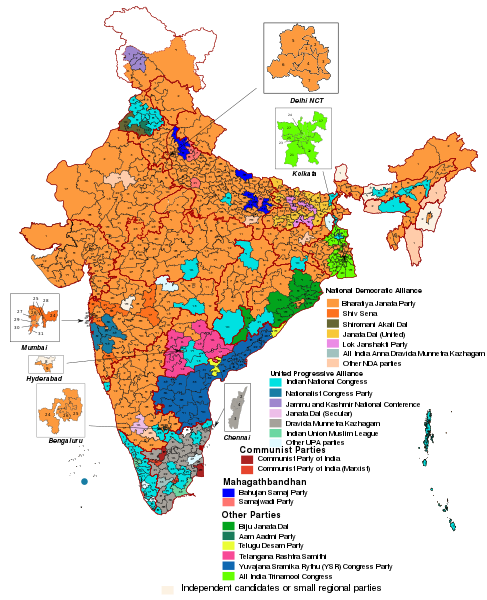 Breakdown of results for 2019 Indian General Election / Image: fair use
Breakdown of results for 2019 Indian General Election / Image: fair use
The other regional parties such as the SP, BSP, YSRC and Left all managed only 99 seats in total. This dismal result by these mostly strongly regional parties, some of which have ruled their states for decades, also clearly reveals the rottenness of their political programmes and casts uncertainty over their futures.
The communist parties, the CPI and CPI(M), could only win 5 seats in total. For the first time since 1952, the Left Front failed to get double digits in a general election. They were completely swept away in West Bengal, losing all the seats they contested. They had ruled this state for 34 years continuously before being voted out of power by the right-wing TMC in 2011. But still, they were clinging to the role of opposition in this state. Now, for the first time, they couldn't even get the second position in all 42 seats of the National Assembly in this state.
It is clear that the left has completely collapsed in West Bengal and the BJP has emerged as the second party, increasing its tally of two seats in the last general elections to 18 seats now. During the election campaign, the right-wing TMC waged a fierce battle in this state against the BJP, in which many political activists were killed on all sides. The BJP is also claiming that many members and voters of the communist parties have joined their ranks, along with others. This claim is also proved by the vote share of the BJP, which has increased to 40.1 percent in West Bengal from 17.2 percent, while the left plummeted to 6.28 percent from the 23 percent they got in the 2014 elections. According to some reports, the CPI (M) actually supported the BJP against the TMC and even had some of their cadres campaign for the party. If this is true, it is a complete betrayal of the working class struggle and it only goes to show the reasons for the CPI (M)’s continuous decline over the past years.
On top of this, there are the infamous incidents of Nandigram and Singur, when the CPI-M administration sanctioned the opening of fire on peasants protesting for their rights, which still haunt the Left Alliance. The struggle against the Tata car plant also was the beginning of the decline of the left in Bengal.
The left also lost both its seats to the BJP in the tiny state of Tripura where it had ruled for many decades, although it had already been voted out of power in the state last year. In Kerala, where the communist parties are governing the state, they could only win one seat out of 20, while the Congress-led alliance (UDF) won a majority and succeeded in blocking the BJP's victory in all the seats in this state. Apart from Kerala, the left won four seats in the southern state of Tamil Nadu only because of their coalition with DMK (a regional party involved in many corruption scandals) and the Congress alliance.
Most of the northern states, including Rajasthan, Haryana, Uttarakhand, Himachal Pradesh, MP, Bihar, Chattisgarh and Jharkhand were taken by the BJP and its alliance, along with huge victories in the north-eastern states like Assam.
Congress was only able to win in the southern states of Tamil Nadu and Kerala, and in the north-western state of Punjab, which helped it to gain 51 seats in total. In the southern state of Karnataka (with Bangalore as its capital), where Congress is ruling in a coalition, the BJP won 25 seats out of 28. In Delhi, the AAP (a right-wing party) was in power in the state government, and was swept away by the BJP, which claimed all seven seats.
In the largest state of UP, with the highest number of seats (80), the BJP won 64, while the alliance of local parties in fierce opposition (SP and BSP) could only manage 15 seats. These so-called socialist parties, who base their politics on the lower castes of the state and have ruled for many decades, were quite confident in their ability to defeat the BJP this time, after overcoming their bitter rivalry and including other local parties in their alliance, except Congress. For their part, Congress could only win a single seat here, with Sonia Gandhi. The biggest setback for Congress also came from here, as its leader Rahul Gandhi lost his ancestral seat in Amethi to the BJP's Smirti Irani. Congress has occupied this seat since 1967 and its loss was a national shame and humiliation for the party and its leader. The BJP won 71 seats in the last elections and only lost a few seats this time, despite installing a reactionary, right-wing Hindu fundamentalist, Yogi Adityanath, as chief minister of the state after winning state elections a few years ago. This is being described as the death knell for these regional parties and their caste-based politics, which have done nothing to alleviate the poverty and misery of millions of lower-caste people living in the state.
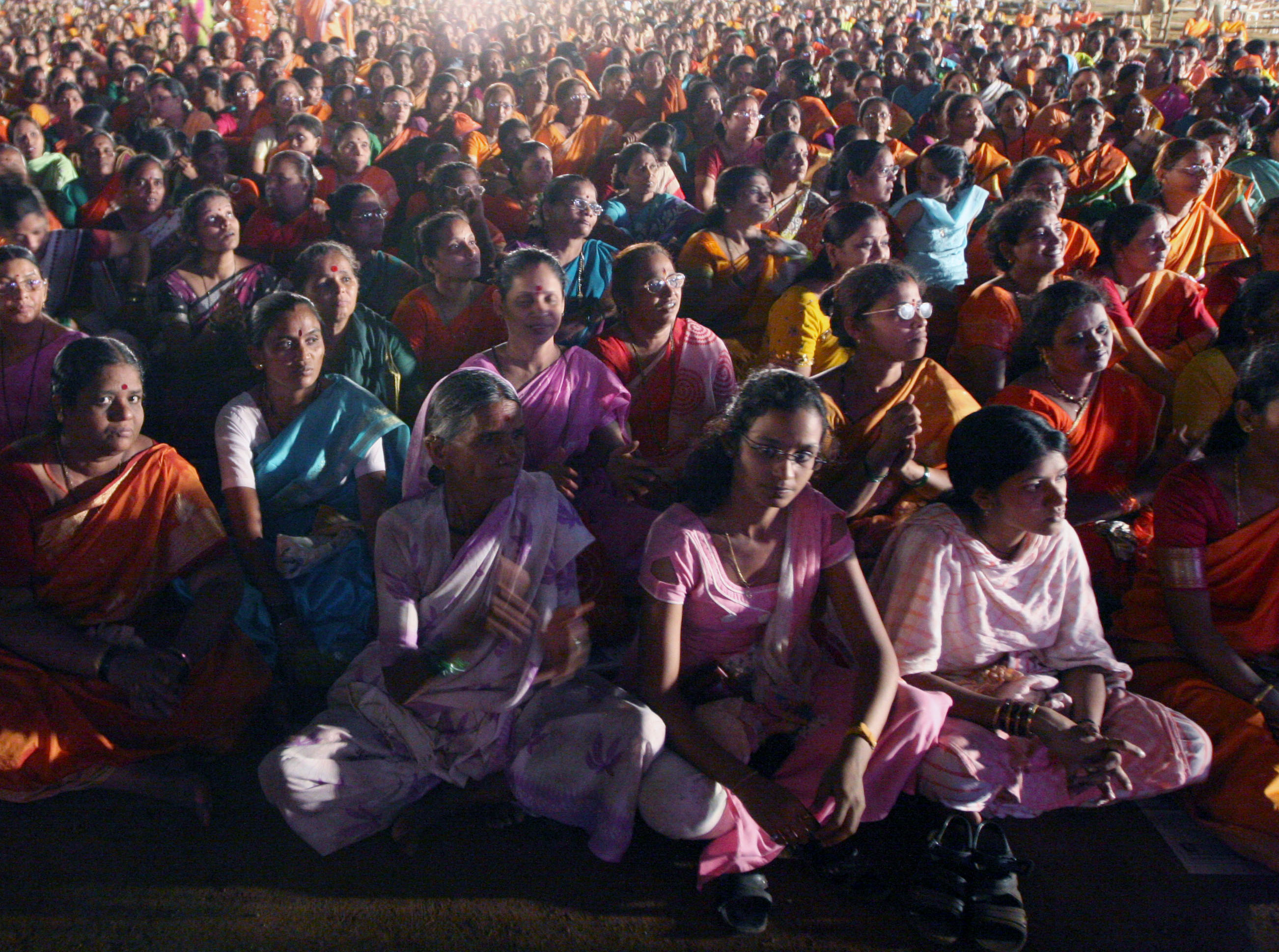 600 million voters participated across India on a turnout of 67.1 percent, in which the majority of young and especially first-time voters opted for the BJP / Image: Flickr, Al Jazeera English
600 million voters participated across India on a turnout of 67.1 percent, in which the majority of young and especially first-time voters opted for the BJP / Image: Flickr, Al Jazeera English
In Maharashtra, whose capital is Mumbai, the BJP was in alliance with the ultra-right wing Hindu fundamentalist party Shiv Sena, which won 18 seats, while the BJP won 23, defeating Congress and its alliance by a huge margin. This state has seen huge protests of hundreds of thousands of farmers in the last few years, which were led by the communist parties. But these parties proved incapable of converting these protests into electoral victories and most of the rural seats were won by Shiv Sena, consolidating its power in the state.
The one state where neither the BJP nor Congress could win a single seat was Andhra Pradesh. Here, a local party, YSRC, won 22 of the 25 seats, while the other nationalist party, TDP, won 3.
The Modi wave?
The surprising electoral victory is being touted as the result of Modi’s charismatic personality and his articulate team, led by his henchman Amit Shah. Most of the commentators and critics are also ascribing this victory to the extravagant use of ill-gotten money, along with a well-planned media campaign. The use of social media, along with banners and posters hanging in every nook and corner of this huge sub-continent, no doubt needed major planning and plenty of money. Also, the BJP manipulated the print and electronic media quite successfully, using coercion and threats where necessary.
The last five years of Modi's rule are being termed as being the worst years for journalism in India, in which some leading left-wing journalists like Gauri Lankesh were murdered by reactionary, right-wing elements. The use of the police and other institutions of the state to coerce voters, and especially religious minorities and low-caste Hindus, was also widespread across the country. Modi is also known for the Hindu-Muslim riots of 2002 in Gujarat, when he was the chief minister of the state. Around 2,000 people were killed in those riots, while many more were injured and made homeless. Mob lynching at various places by fundamentalists became a common routine in the last five years and these threats were used extensively during the campaign.
The partiality of the Election Commission of India also came under attack during this election campaign when it made a lot of decisions favouring the incumbent BJP. One of these decisions was to allow Pragya Thakur to contest the elections from Bhopal, MP. She is accused of being behind a terrorist attack in Malegaon in 2006 in which at least 40 people were killed, and she is still on trial for that case. She also publicly glorified another Hindu fundamentalist, Nathuram Godse, who was Gandhi’s assassin. Though she was able to win her seat in the elections with a wide margin, her candidacy was considered illegal by the opposition. Many opposition leaders criticised the Election Commission and called it the election omission instead.
There were also many allegations of rigging and fraud in the elections, and especially, the hacking and rigging of Electronic Voting Machines (EVMs) which has become a popular allegation in India. Reports of phantom votes in some constituencies in Bihar and UP also tainted Modi's electoral victory. A report from a news website, The Quint, claims that there is a mismatch between registered votes and the turnout in more than 370 constituencies, and has demanded a reply from the Election Commission, which has not been given. However, in spite of all these allegations, the scale of the victory shows that the BJP election machine has manoeuvred a comprehensive victory, by hook or by crook.
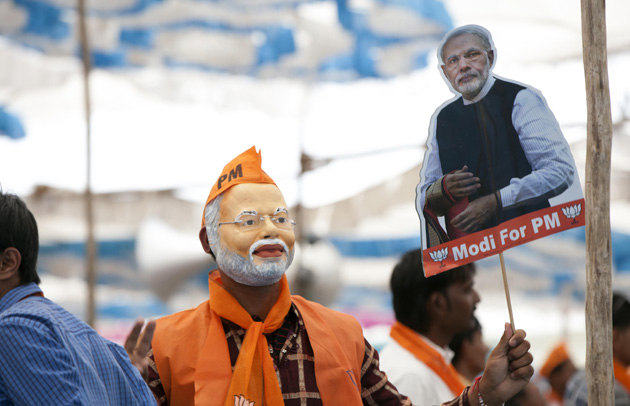 Unlike in 2014, where he focused on slogans of progress and development, Modi's 2019 campaign was based on unbridled Hindu nationalism and bigotry / Image: Prime Ministers Office Government of India
Unlike in 2014, where he focused on slogans of progress and development, Modi's 2019 campaign was based on unbridled Hindu nationalism and bigotry / Image: Prime Ministers Office Government of India
In 2014, Modi based his campaign on the slogans of “development and progress”, criticising the previous 10-year rule by Congress tainted by corruption scandals and economic crises. But this time, there was no discussion about these slogans and no answers were given about the rising unemployment and inflation in the country. Rather, the whole campaign was based on extreme, right-wing religious slogans drawn from the ideology of Hindutva or Hindu fundamentalism. The use of nationalist jingoism and war mongering was also at a peak, with Modi and his party mostly using anti-Pakistan rhetoric in their speeches.
In February, just one month before the elections, Modi attacked Pakistan by sending fighter jets across the border to drop bombs on a religious seminary in Balakot, Pushtoonkhwa. The trigger was a suicide bomb blast in Pulwama, in Indian-held Kashmir, in which 40 paramilitary troops were killed. Jaish-e-Muhammad, a terrorist organisation in Pakistan, claimed responsibility for this attack, though later they denied it. Modi alleged that the seminary that India attacked was a centre of Jaish-e-Muhammad, led by Masood Azhar, which has carried out several other terrorist attacks inside India before. Though later reports confirmed that the bombs missed their target and nobody was killed, this was still a violation of an international border, which provoked tensions between these nuclear-armed neighbours and brought them close to full-scale war. Next day, in retaliation, an Indian fighter plane was shot down by Pakistan and its pilot arrested, although Modi got him released in a couple of days through international pressure and by mounting troops on the border. Again, this was claimed as a victory against the enemy and used as a key election slogan, with Modi presenting himself as the "Chowkidar" (watchman) of the nation. The opposition replied with the slogan of "Chowkidar chor hai" (watchman is a thief) referring to the corruption scandals surrounding Modi.
Along with the nationalist rhetoric, the use of religious hatred was also prevalent and religious minorities were pushed to the sidelines, along with low-caste Hindus. The BJP’s slogans pushed the discussion on the economic crisis and unemployment to the back burner during the election campaign, and allowed the BJP to manipulate its way to an electoral victory.
It is also clear that the Indian capitalists gave their overwhelming support to the BJP. The Indian stocks rallied to their strongest performance in three years on the day when initial exit polls confirmed Modi's victory. Modi also received huge financial support from the filthy rich giants who had benefited immensely from his anti-labour policies. From demonetisation to doling out big contracts to his favourites, Modi gave unprecedented favours to the bourgeoisie, while unleashing brutal attacks on the working-class during his rule. All this helped to liberalise the finance sector to fill the coffers of the super-rich, while forcing millions below the poverty line. Modi’s strongman image was used to crush the trade unions in India, leaving the workers at the mercy of the capitalists, facing more exploitation with longer working hours, reduced wages and without any job security. Another term for Modi also means much more brutal attacks on the working class, increasing the profits of the Indian bourgeoisie. This wonderful prospect was reflected in the jubilation of the stock markets when the results were finally announced.
Many left-wing analysts and opposition leaders are claiming this as the “victory of fascism” in India, comparing it with Hitler's victory in Germany. Opposition leaders and critics are blaming the masses for all this and are hanging their heads in complete dejection and gloom.
But the results need a clear evaluation. The reasons for this right-wing victory are to be found in the ideological bankruptcy of the left in particular, the two main Communist Parties, and the bourgeois opposition led by Congress as a whole, who are still tainted with the policies they carried out when they ran the country in the past. Blaming everything on the masses and calling them traitors to the “secular traditions” of India, or ignorants who fell for the bigotry and chauvinism of the BJP, will make matters even worse, and prevent the left as a whole from finding a solution to stop this reactionary onslaught.
Secularism
It was not the first time that bigotry and religious hatred have been used in Indian politics. Almost all the mainstream parties have used these tools to manipulate election victories, though on a relatively smaller scale. The difference now is that the BJP has used this reactionary tool more blatantly and shamelessly, while previously it was used hypocritically under the garb of religious harmony. Congress has always politically manoeuvred behind these slogans to get electoral victories, while blackmailing the voters to support them lest reactionary forces take over the country. The slogan of religious harmony in India is, in reality, a slogan to divide people on religious lines. Similarly, the slogan to give the lower castes more opportunities through special quotas only helps to strengthen the caste system and reinforce centuries-old divisions, allowing them to continue under 21st-century capitalism.
In fact, the partition of India at the time of Independence in 1947 was carried out on a religious basis, in which Nehru and Gandhi, the leaders of Congress, played a leading role in forging complete collaboration with the British Imperialists. Though blame for the partition is often laid on Jinnah, the founding father of Pakistan, and his Muslim League, they were merely extras in this real-life bloody drama, where Congress was at the forefront. Since then, the slogan of secularism has been used hypocritically to carry on with injustices and oppression against the working class. Whenever there is fear of a movement of the working class, religious hatred is used to divide the masses and continue the rule of big business. In fact, religious fundamentalism has always raised its ugly head only with the support and backing of the bourgeoisie, in collaboration with Congress, to counter the left-wing movements arising from the working class. Shiv Sena in Maharashtra is a striking example of this, which was propped up in 1970s and later used as a tool by the industrialists of Mumbai to counter the strong influence of communists in the trade unions there. This monster has now assumed a life of its own and requires a strong, working-class movement to overthrow it.
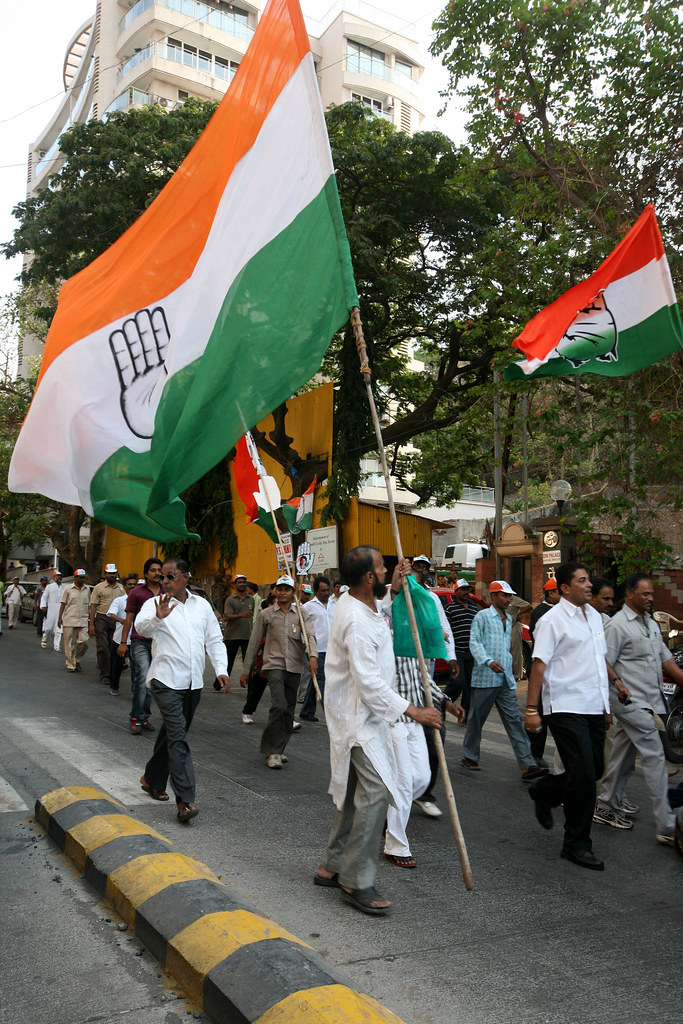 Congress tried to get back into power on the hollow slogan of secularism, but was also at times more reactionary and Hindu fundamentalist than the BJP itself / Image: Flickr, Al Jazeera English
Congress tried to get back into power on the hollow slogan of secularism, but was also at times more reactionary and Hindu fundamentalist than the BJP itself / Image: Flickr, Al Jazeera English
In these elections, the slogan of secularism was used as a rallying call to unite all the opposition against the BJP and was considered the uniting thread for all the anti-BJP forces. But the results have clearly shown that this scheme has failed miserably. In fact, one of the main reasons for Modi's victory is the complete collapse of the opposition parties, who are living in the past and using old tactics to counter a new threat. In fact, this was the first election that saw a BJP/anti-BJP contest, while all the previous ones were Congress/anti-Congress contests at the national level.
Congress, though trying to get back into power on the hollow slogan of secularism, which explains nothing to the masses, in fact fell into the BJP’s trap and was at times more reactionary and Hindu fundamentalist than the BJP itself. Rahul Gandhi and his sister Priyanka tried their best to appeal to the religious sentiments of Hindus and visited many important temples during the campaign. But despite all these efforts, they failed to increase their vote share, which remains stagnant at 19.5 percent (versus 19.3 percent in 2014), while the BJP increased its share from 31 percent in 2014 to 37.4 percent of the total votes in 2019. Congress also hesitantly tried to expose the corruption scandals of the BJP during its five-year rule, in addition to highlighting the economic problems in that period, but in the end couldn't provide an alternative. Navjot Singh Sidhu, a leader of Congress from Punjab, harshly criticised the privatisation policy of Modi and hailed the superiority of the public sector in a press briefing, but this programme didn't match with the policy of Congress-led governments in the last three decades, which was one of aggressive privatisations. In fact, Congress had no real alternative to the policies of the BJP and was looked upon as a meek and timid version of the BJP by young voters and the bourgeoisie alike. Also, on the issue of confrontation with Pakistan, Congress and all other opposition parties had no alternative position and toed the same line as the BJP, only more hypocritically and deceitfully.
The position of regional parties was no different, including the SP and BSP in Uttar Pradesh. These two parties had successfully manoeuvred behind their caste-based politics over many decades, only to the benefit of a tiny minority. While a majority of these castes continue to live in extreme poverty and misery, the leadership of these parties consistently used bigotry and caste hatred to secure electoral victories. But the BJP has outclassed them in using fear, intimidation, killings, bribes, criminal gangs, religious and caste hatred and bigotry to achieve electoral success at an unprecedented level. Influencing the state machinery to achieve its goals has also been more skillfully applied than ever before. The BJP has also correctly criticised all these parties for dynasty politics, and claiming to be the only party (except the communist parties) in which an ordinary member can rise to the top. In fact, Modi’s 2014 election campaign centred around the theme of class differences, with Modi being the son of a tea seller at railway stations; whereas Rahul Gandhi of Congress is the son, grandson and great-grandson of the previous prime ministers. Modi called him a political prince and hypocritically led a campaign of sloganeering against the rich. But this time, all those empty slogans were discarded to unleash a wave of bigotry and hatred unabashedly. Both times, Congress was on the receiving end.
A discussion of the revival of the Congress and all other opposition parties has started after the elections, in which many suggestions are being discussed. Most of the debates revolve around better strategies and ways to counter the BJP, and to attract young voters skillfully through improved media campaigns and slogans. Rahul Gandhi has tendered his resignation to the central working committee but it is quite obvious that he will still continue as the main leader. The condition of the leaders of other parties is no different.
However, few have the courage to see beyond the spectrum of the existing political parties in India. Though dozens of new political parties are registered in India every day, very few are able to make any mark. These elections have opened up a new Pandora's Box and all kinds of debates have started around the future of politics in India. Many seasoned intellectuals and analysts are keen for the revival of the Congress and other mainstream parties, though at the moment, hopelessness and gloom are prevailing over them. But it is quite possible now to envision a future with new parties replacing the old ones.
This is also likely because the ground is being prepared for new, stormy events, which will transform this situation completely. New parties could emerge from nowhere, at a regional as well as national level, to take on the reaction of BJP with full force. Recent general strikes and huge demonstrations of farmers in various states have demonstrated the possibility of new political parties taking shape, as all the existing ones have failed to lead these movements from economic demands to the political arena. These protests and strikes, involving millions of people, have shown time and again that people want to solve the economic crisis and to come out forcefully. But the leadership of these organisations and parties are not giving them a way forward and are restricting these movements to economic demands. In the coming period, all this will be repeated on a much-bigger scale and will expose the complete rottenness of existing parties. The upcoming revolutionary movements will sow the seeds of new parties and organisations in India for future generations to reap the benefits. Though this prolonged process will not unfold in a straight line and will be full of contradictions, it is ultimately destined to announce the death of this whole political spectrum.
At this point, many would refer to the recent phenomenon of the AAP (“Common Man”) party, which emerged out of a right-wing, anti-corruption movement of 2011 in Delhi. But with its clumsy politics and petty-bourgeois character, it has also collapsed and is reduced to just one seat in the National Assembly, from four it won in 2014. Its state government in Delhi is also in deep crisis and will possibly lose to the BJP in the next elections. This will not hinder new parties from emerging in the coming period from the right, but they will most likely be on the left, as the collapse of the existing left parties has opened up a huge space, which is now up for grabs.
The stormy period ahead
Modi’s second term is being looked upon by big business as a great opportunity to exploit the masses to the full. The multinationals and big businesses internationally have also welcomed Modi's success and are eyeing India under his leadership as a safe haven in an increasingly polarised climate between the US and China. Many companies are thinking of shifting their businesses to India from China to avoid US sanctions, although Trump has also threatened India with new tariffs. But still, many are looking at the high growth rate and the huge profits Indian companies have made during the last five years of Modi’s rule. China has also welcomed Modi and is looking forward to mending its ties with India to benefit from this huge market. Already, China has a big trade surplus with India and, after sanctions from the US, is looking forward to increasing its bilateral trade with India. On the other hand, the conflicting imperialist interests between India and China in the region are also coming to the fore. All this will sharpen the contradictions and impact political developments in the coming period.
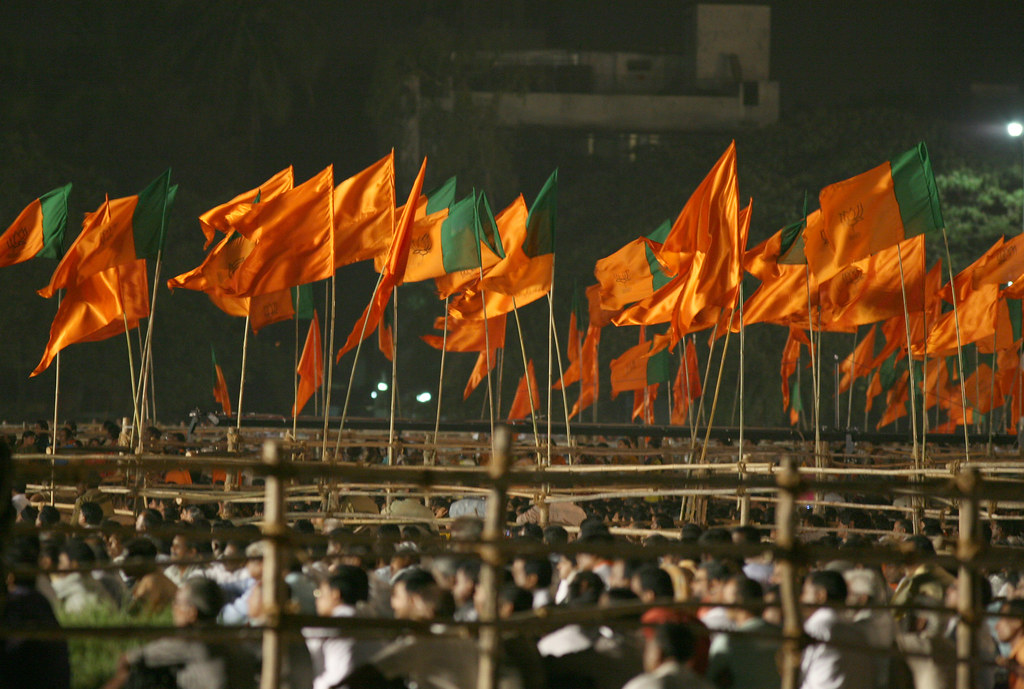 Modi's victory is a whip of counter-revolution that will drive the revolutionary masses onto the stage of history to take their destiny in their own hands. It is time for a renewed class struggle in India / Image: Flickr, Al Jazeera English
Modi's victory is a whip of counter-revolution that will drive the revolutionary masses onto the stage of history to take their destiny in their own hands. It is time for a renewed class struggle in India / Image: Flickr, Al Jazeera English
For the working class, this means more exploitation, more cuts to living standards and more liberalisation of the economy on a scale never seen before. Modi will try to use this huge victory to crush the working class under his boot and provide a "friendly" climate for investors, where they can exploit their workers at leisure. The process of privatisation will accelerate and big public sector companies, including the finance sector, will be sacrificed on the altar of private capital. In a talk with the media after the elections, top official Rajiv Kumar, vice chairman of NITI Aayog (National Institute for Transforming India) said that, in the first 100 days of Modi's second term, a slew of 'big bang' economic reforms are likely to be pursued to please foreign investors. These include changes in labour laws, privatisation and the creation of land banks for new industrial developments.
This is a finished recipe for class struggle, which will intensify in the coming period. Already, the 6.1 percent unemployment rate in 2017-18 is the highest of the last 45 years, while the economy has slowed down from 6.8 percent to 5.8 percent growth in the period from January to March, reflecting the impact of the crisis in the world economy. The last five years of Modi’s rule saw some of the biggest general strikes in history, mobilising around 200 million workers on one day. The protests by farmers across the country are increasing, and more and more sections of society are coming out to protest for their rights. The student movement has also been building up over the course of these years and is looking for new ideas and methods to achieve their goals. All those banging their heads against the wall at the victory of right-wing reaction need only wait and see, because these movements will grow enormously in the coming months and years. We will witness historic events begin to unfold. In fact, Modi's victory is a whip of counter-revolution that will drive the revolutionary masses onto the stage of history to take their destiny in their own hands. It is time for a renewed class struggle in India.
If anyone has any doubts about this, it is sufficient to look at Brazil where only one year ago Bolsonaro was triumphant, and where all the talk was of “fascism”. Now one year later we see how the masses are not prepared to take his anti-worker policies and are coming out onto the streets to protest in huge numbers. The same will happen in India once Modi - enormously encouraged by his recent victory - goes on the offensive against the Indian working class.
Which way forward?
The humiliating defeat of the communist parties in fact shows the bankruptcy of Stalinism and its degeneration into parliamentary cretinism, provincialism and enormous corruption. All the efforts to revive the left have once again failed and it is evident that, without a complete overhaul of its ideological grounds, no revival is possible. Still, many are proposing to change electoral tactics and strategies, which is like skating on the surface without looking beneath it. Another mantra is to infuse the party with young blood, which often means the young children and siblings of the leaders of the party. While remaining in power for many decades at state level and sharing governments at the centre, these left parties have comprehensively adopted the ideologies and methods of other bourgeois parties and it is hard to point out any differences among them.
The left has no alternative to the farcical secularism of Congress, in fact it was in coalition with it in many places. Similarly, it has no position of class solidarity with the working class of other countries in the region, including Pakistan, and follows the same nationalist approach as other parties – defending Indian nationalism at every juncture. This is why they had no answer to the jingoistic election campaign of the BJP and fell into their trap, or rather became a casualty of this war.
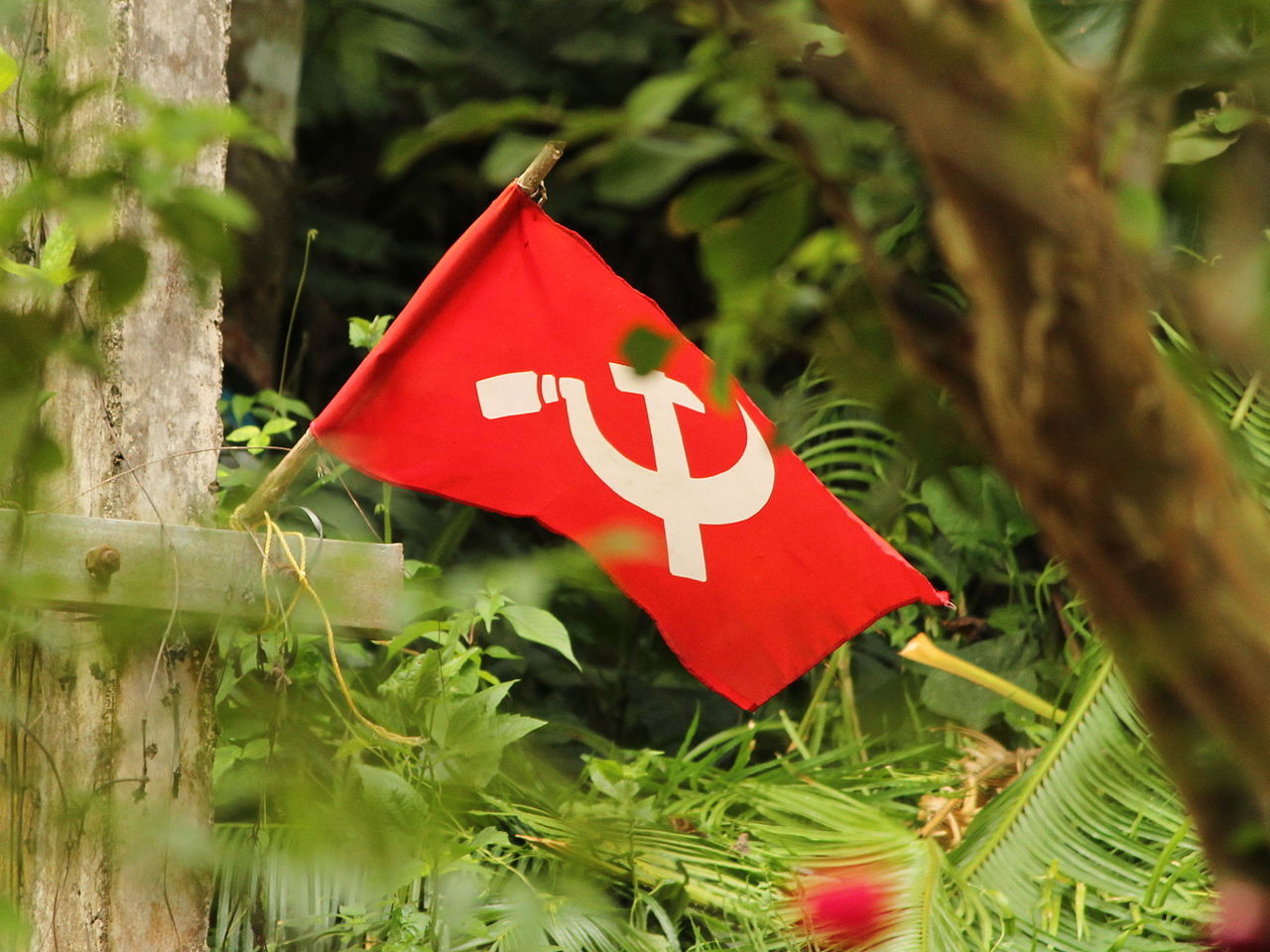
Marxism is internationalist or it is nothing and Marx raised the slogan of the unity of the working class across the globe. But the left in India has long forgotten the essence of this slogan and has abandoned internationalism for petty power politics at state level. This is why they ended up with their biggest-ever defeat in West Bengal, where some Marxist ideas had been part of the curriculum in schools over a long period. The BJP attracted the voters of these left parties in this state on the slogan of religious hatred only because the left had no alternative position of class solidarity.
The left’s position on the national question is also not much different from any other party and the left was unable to see beyond the narrow confines of the Indian bourgeois state. A huge mass movement is underway in Kashmir, where hundreds of thousands have been protesting for over two years against the atrocities of the Indian state. The Pakistani state has also tried to derail this movement on religious lines and towards individual terrorism but has not succeeded as it did in the 1990s. The masses in the Kashmir valley have rejected not only the occupation of the Indian state but also the reactionary role played by Pakistan. But the communist parties couldn't provide a platform in India on class lines to express solidarity with this movement and win it over. The movement is still continuing with full force amid severe repression, facing the hatred of the state institutions, which was also expressed in these elections, where the turnout was around 9 percent in the valley. Similarly, the left failed to offer an alternative in the north-eastern states, where the BJP has replaced Congress as the biggest party in an unprecedented and unexpected development. This expresses the complete failure of Stalinism to address the national question.
This is a time of reckoning for the left, especially the youth, amongst whom not only the mainstream communist parties but those following the wrong methods of armed struggle and incorrect ideology of Maoism have also failed. Armed struggle not only gives the state an excuse to escalate its repression but also alienates the working class. The exaggerated emphasis of these parties on the agrarian question only helps to diminish the role of the working class, which in India is one of the biggest in the world.
It is time to revisit the theory of permanent revolution as developed by Trotsky, and to follow the Bolshevik method of party building laid down by Lenin, to come out of this crisis. The only hope lies with the young generation, which wants to fight against a dark future of unemployment, poverty and illiteracy under Modi. They need to prepare for huge, earth-shattering events on the horizon, which will rock the political situation from top to bottom. The way forward is not through organisational intrigues inside the parties and petty changes at the top, but through a complete overhaul of the ideological basis of the left, and reviving the internationalist spirit of Marxism with the ideas of Trotskyism, which is a continuation of Marxism and Leninism.
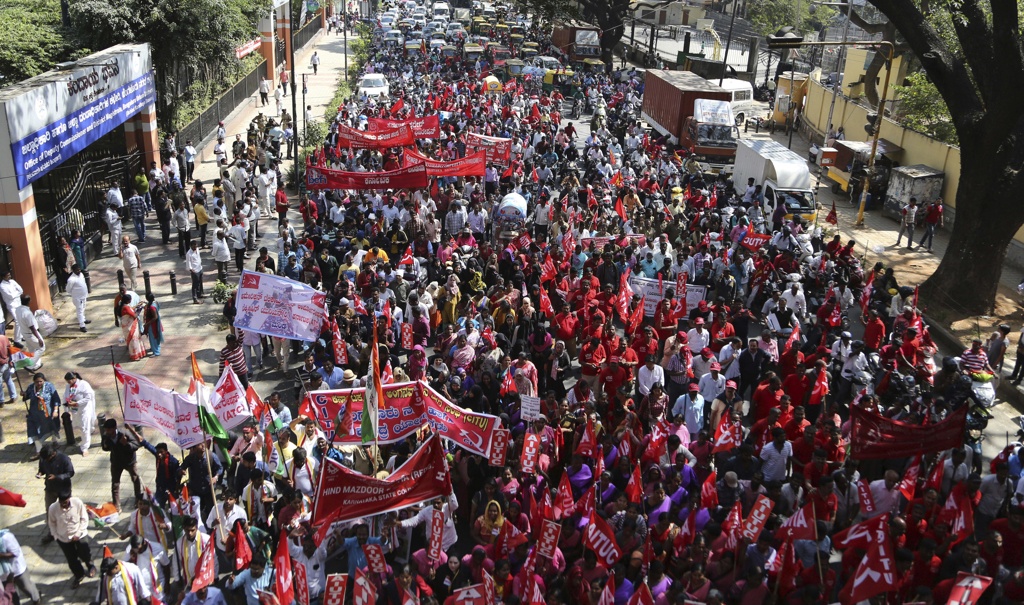 Despite the despair on much of the left, the last five years saw some of the biggest general strikes in history, protests by farmers across the country, and a growing student movement. Struggle is on the agenda / Image: fair use
Despite the despair on much of the left, the last five years saw some of the biggest general strikes in history, protests by farmers across the country, and a growing student movement. Struggle is on the agenda / Image: fair use
The victory of the BJP is not the defeat of the Indian proletariat. Also, fascism has not yet arrived, although its dark clouds are hovering on the horizon. In fact, this victory of the BJP reveals the exhaustion of bourgeois democratic methods. The limits of the Indian constitution (much revered by all and sundry and treated like a God in India) and the bourgeois state have been laid bare in these elections. This bourgeois state has failed to provide the basic needs of millions living in extreme poverty, disease and misery from its very beginning, but now it is also unable to safeguard the much-adored and worshipped institutions of bourgeois democracy itself. The empty slogans of “development and progress” have also failed time and again. The state capitalist and neo-liberal methods of running this capitalist state have also revealed their complete bankruptcy in India. The only way forward is the socialist transformation of society through a revolution in which the proletariat will play the leading role. Only through a planned socialist economy can this class-based system be brought to an end, and 1.3 billion people be emancipated from their miserable lives under capitalism. The Indian socialist revolution will only be the beginning of a world revolution, which will emancipate humanity from the rule of capital.

